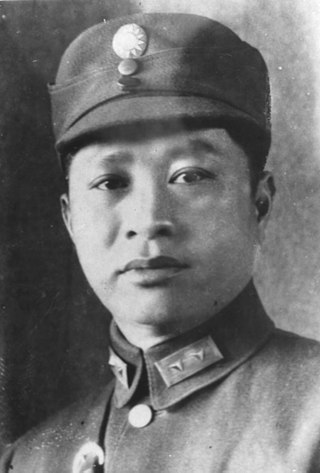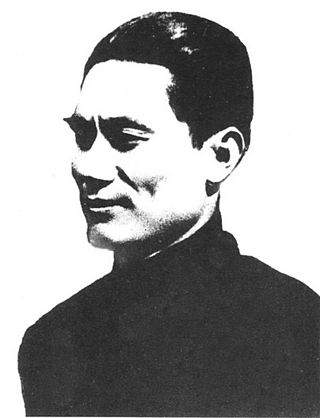
The Northern Expedition was a military campaign launched by the National Revolutionary Army (NRA) of the Kuomintang (KMT) against the Beiyang government and other regional warlords in 1926. The purpose of the campaign was to reunify China, which had become fragmented in the aftermath of the Revolution of 1911. The expedition was led by Generalissimo Chiang Kai-shek, and was divided into two phases. The first phase ended in a 1927 political split between two factions of the KMT: the right-leaning Nanjing faction, led by Chiang, and the left-leaning faction in Wuhan, led by Wang Jingwei. The split was partially motivated by Chiang's Shanghai Massacre of Communists within the KMT, which marked the end of the First United Front. In an effort to mend this schism, Chiang Kai-shek stepped down as the commander of the NRA in August 1927, and went into exile in Japan.

The Nanchang Uprising was the first major Nationalist Party of China–Chinese Communist Party engagement of the Chinese Civil War, begun by the Chinese Communists to counter the Shanghai massacre of 1927 by the Kuomintang.

Ye Jianying was a Chinese Communist revolutionary leader and politician, one of the Ten Marshals of the People's Republic of China. He was the top military leader in the 1976 coup that overthrew the Gang of Four and ended the Cultural Revolution, and was the key supporter of Deng Xiaoping in his power struggle with Hua Guofeng. After Deng ascended power, in his capacity as Chairman of the Standing Committee of the National People's Congress, Ye served as China's head of state during the period from 1978 to 1983.

Zhang Guotao, or Chang Kuo-tao, was a founding member of the Chinese Communist Party (CCP) and rival to Mao Zedong. During the 1920s he studied in the Soviet Union and became a key contact with the Comintern, organizing the CCP labor movement in the United Front with the Kuomintang. From 1931 to 1932, after the Party had been driven from the cities, Zhang was placed in charge of the Eyuwan Soviet. When his armies were driven from the region, he joined the Long March but lost a contentious struggle for party leadership to Mao Zedong. Zhang's armies then took a different route from Mao's and were badly beaten by local Muslim Ma clique forces in Gansu. When his depleted forces finally arrived to join Mao in Yan'an, Zhang continued his losing challenge to Mao, and left the party in 1938. Zhang eventually retired to Canada, in 1968. He became a Christian shortly before his death in Scarborough, Ontario, in 1979. His memoirs provide valuable and vivid information on his life and party history.

Xue Yue was a Chinese Nationalist military general, nicknamed the "Patton of Asia" by Claire Lee Chennault of the Flying Tigers and the "God of War" (戰神) by the Chinese.

Ye Ting, born in Huiyang, Guangdong, was a Chinese military leader who played a key role in the Northern Expedition to reunify China after the 1911 Revolution. After serving with the Kuomintang, Ye later joined the Chinese Communist Party (CCP).

The Shanghai massacre of 12 April 1927, the April 12 Purge or the April 12 Incident as it is commonly known in China, was the violent suppression of Chinese Communist Party (CCP) organizations and leftist elements in Shanghai by forces supporting General Chiang Kai-shek and conservative factions in the Kuomintang. Following the incident, conservative KMT elements carried out a full-scale purge of communists in all areas under their control, and violent suppression occurred in Guangzhou and Changsha. The purge led to an open split between left-wing and right-wing factions in the KMT, with Chiang Kai-shek establishing himself as the leader of the right-wing faction based in Nanjing, in opposition to the original left-wing KMT government based in Wuhan, which was led by Wang Jingwei. By 15 July 1927, the Wuhan regime had expelled the Communists in its ranks, effectively ending the First United Front, a working alliance of both the KMT and CCP under the tutelage of Comintern agents. For the rest of 1927, the CCP would fight to regain power, beginning the Autumn Harvest Uprising. With the failure and the crushing of the Guangzhou Uprising at Guangzhou however, the power of the Communists was largely diminished, unable to launch another major urban offensive.

The Canton Coup of 20 March 1926, also known as the Zhongshan Incident or the March 20th Incident, was a purge of Communist elements of the Nationalist army in Guangzhou undertaken by Chiang Kai-shek. The incident solidified Chiang's power immediately before the successful Northern Expedition, turning him into the paramount leader of the country.

Zhang Tailei was the leader of the Guangzhou Uprising, during which he was killed.

Deng Yuanzhao or Deng Fa was an early leader of the Chinese Communist Party. He was born in Yuncheng District, Yunfu, Guangdong, and participated in the Canton–Hong Kong strike and the Guangzhou Uprising in his youth. He later engaged in underground work in Guangzhou and Hong Kong for the CCP, and become Party Committee Secretary of Guangzhou and Hong Kong and head of the Organisation Department in Guangdong.
The Little Long March was a 600-kilometre (370 mi), two-month withdrawal by left-wing members of the Kuomintang and the National Revolutionary Army up the Gan River and down to the coast, subsequent to the successful mutiny and insurrection at Nanchang on August 1, 1927.
The Battle of Shantou occurred in September–October 1927 during the first phase of the Chinese Civil War in China.
The Hailufeng Soviet was the first Chinese Soviet territory, established in November 1927, by Peng Pai with Ye Ting's remnant troops from the Nanchang Uprising. After the Little Long March and the near-rout at the Battle of Shantou these troops were much diminished and were directed by the ComIntern to lie low in the deep countryside and to avoid any further battles.

Zhang Yunyi, was a Communist revolutionary and military strategist of the People’s Republic of China. Born in Wenchang, Hainan, he joined the Chinese Communist Party in 1926, and took part in the Northern Expedition, the Nanchang Uprising, the Baise Uprising, the Second Sino-Japanese War and the Chinese Civil War. Zhang held the posts of the army commander of the 7th Red Army, the assistant staff officer of the Military Commission of the Central Committee of the CCP, the commander of a military area, etc., and was named one of the ten Senior Generals in 1955. The Zhang Yunyi Memorial Hall is located in Wenchang, Hainan Province.
Vietnamese Revolutionary Youth League, or Thanh Niên for short, was founded by Nguyen Ai Quoc in Guangzhou in the spring of 1925. It is considered as the “first truly Marxist organization in Indochina” and “the beginning of Vietnamese Communism”. With the support of Chinese Communist Party and the Kuomintang Left, during the period of 1925-1927, the League managed to educate and train a considerable number of Marxist-Leninist revolutionaries, preparing the prominent leadership for the Communist Party of Vietnam and the Vietnamese Revolution. At the time, Vietnam was part of colonial French Indochina.

The Chinese Red Army, formally the Chinese Workers' and Peasants' Red Army or just the Red Army, was the military wing of the Chinese Communist Party from 1928 to 1937. It was formed when Communist elements of the National Revolutionary Army splintered and mutinied in the Nanchang Uprising. The Red Army was reincorporated into the National Revolutionary Army as part of the Second United Front with the Kuomintang to fight against the Japanese during the Second Sino-Japanese War of 1937–1945. In the later stages of the Chinese Civil War they splintered off once again and renamed the People's Liberation Army.

Tan Pingshan was a Chinese revolutionary socialist and an early member of the Chinese Communist Party (CCP) from Gaoming, Guangdong. He was influential in the Tongmenghui and formed the Guangdong branch of the CCP with the help of Chen Duxiu. He later took part in the formation of the Revolutionary Committee of the Chinese Kuomintang.
The Battle of Guangzhou was an internal conflict within the National Revolutionary Army in the aftermath of Chiang Kai-shek's successes in the Northern Expedition. It occurred shortly after the Chinese Communist Party-led Guangzhou Uprising, which was crushed by Li Jishen's opponent Zhang Fakui. On December 28, 1927, Li Jishen's forces were able to capture Guangzhou, and Miao Peinan retreated to Huizhou. On December 29, 1927, local leader Li Fulin, an opponent of Li Jishen, was removed from office and replaced with Deng Yanhua.

Ye Jizhuang was a Chinese Communist revolutionary and politician nicknamed the "Red Manager". He served as the logistics head of the Red Army during the Long March and of the Yan'an Communist headquarters during the Second Sino-Japanese War. In 1945, he was among the first three officers awarded the rank of lieutenant general by the Chinese Communist Party, together with Peng Zhen and Chen Yun. After the founding of the People's Republic of China in 1949, he served as the country's first Minister of Trade and then Minister of Foreign Trade until his death in 1967.

The Wuhan Nationalist government, also known as the Wuhan government, Wuhan regime, or Hankow government, was a government dominated by the left-wing of the Nationalist or Kuomintang (KMT) Party of China that was based in Wuhan from 5 December 1926 to 21 September 1927, led first by Eugene Chen, and later by Wang Jingwei.















